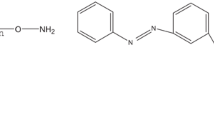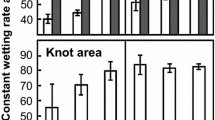Abstract
This study reports on the water uptake (WU) and wetting properties of different modified wood materials; furfurylated and N-methylol melamine (NMM) modified Scots pine, and heat-treated (Vacu3 method) Scots pine and beech. All modifications caused a substantial reduction in WU in the longitudinal, tangential and radial directions both after short (24 h) and long contact times (168, 336 h) with a saturated sponge. The water uptake coefficient (w t ) was reduced by approximately 71–89 % in furfurylated wood, with the higher weight percent gain (WPG) providing a slightly greater reduction. The reduction in WU was not found to depend on the NMM solid content. The NMM treatment had the maximum effect on the reduction of tangential w t by 80–84 % and was much smaller in the longitudinal direction (31–68 %). The treatment temperature of 195 °C gave lower WU values than treatment at 210 °C, and the only exception was the radial direction of Scots pine. The longitudinal w t of heat-treated beech represented the highest reduction by 81–89 %, while radial w t was less affected in both species. Sessile drop apparent contact angles for water and diidomethane and corresponding surface energies on planed tangential and radial wood surfaces revealed an increased hydrophobicity and reduced polarity of modified wood. Furfurylated and NMM modified tangential surfaces had a higher increase of apparent contact angles than the radial surfaces but this was not observed in the case of heat treatment. Heat-treated wood showed reduced wetting of surfaces only with water. Apparent contact angles did neither differ with treatment temperature nor with the NMM resin load. The disperse component of surface energy was slightly increased by 20 % maximum in modified wood, while the polar components showed a dramatic decrease by −30 to −90 % with no major differences among treatments and intensities, and between surfaces. The results provide a better understanding of the hygroscopic behaviour of modified wood, which might be useful to predict its adhesion with various polymers such as glues, coatings and paints.


Similar content being viewed by others
References
Alén R, Kotilainen R, Zaman A (2002) Thermochemical behavior of Norway spruce (Picea abies) at 180–225 °C. Wood Sci Technol 36:163–171
Boonstra MJ, Rijsdijk JF, Sander C, Kegel E, Tjeerdsma B, Militz H, van Acker J, Stevens M (2006) Microstructural and physical aspects of heat treated wood. Part 2. Hardwoods. Maderas Cienc Tecnol 8:209–217
Bryne LE, Wålinder MEP (2010) Ageing of modified wood. Part 1: wetting properties of acetylated, furfurylated, and thermally modified wood. Holzforschung 64(3):295–304
de Meijer M, Haemers S, Cobben W, Militz H (2000) Surface energy determinations of wood: comparison of methods and wood species. Langmuir 16(24):935–939
DIN 52617 (1987) Determination of the water absorption coefficient of construction materials. DIN German Institute for Standardization, Berlin
Donath S, Militz H, Mai C (2006) Creating water-repellent effects on wood by treatment with silanes. Holzforschung 60:40–46
Englund F, Bryne LE, Ernstsson M, Lausmaa J, Wålinder M (2009) Some aspects on the determination of surface chemical composition and wettability of modified wood. In: Proceedings of the 4th European conference on wood modification, Stockholm, pp 553–560
Ghosh S, Militz H, Mai C (2009) The efficacy of commercial silicones against blue stain and mould fungi in wood. Eur J Wood Prod 67:159–167
Ghosh S, Militz H, Mai C (2013) Modification of Pinus sylvestris L. wood with quat- and amino-silicones of different chain lengths. Holzforschung 67(4):421–427
Gindl M, Sinn G, Gindl W, Reiterer A, Tschegg S (2001) A comparison of different methods to calculate the surface free energy of wood using contact angle measurements. Colloids Surf A 181:279–287
Gsöls I, Raetzsch M, Ladner C (2003) Interactions between wood and melamine resins—effect on dimensional stability properties and fungal attack. In: Van Acker J, Hill C (eds) Proceedings first european conference on wood modification. Ghent, Belgium, pp 221–225
Hakkou M, Pétrissans M, El Bakali I, Gérardin P, Zoulalian A (2005) Wettability changes and mass loss during heat treatment of wood. Holzforschung 59:35–37
Hill CAS (2006) Wood modification: chemical, thermal and other processes. Wiley, Chichester
Hunt CG, Brandon R, Ibach RE, Frihart CR (2007) What does bonding to modified wood tell us about adhesion? In: Proceedings 5th COST E34 international workshop: bonding of modified wood. Bled, Slovenia, pp 47–56
Johansson J, Kifetew G (2010) CT-scanning and modelling of the capillary water uptake in aspen, oak and pine. Eur J Wood Prod 68(1):77–85
Kielmann BC, Adamopoulos S, Militz H, Koch G, Mai C (2014) Modification of three hardwoods with an N-methylol melamine compound and a metal-complex dye. Wood Sci Technol 48:123–136
Kocaefe D, Poncsak S, Doré G, Younsi R (2008) Effect of heat treatment on the wettability of white ash and soft maple by water. Holz Roh Werkst 66:355–361
Mahnert K-C, Adamopoulos S, Koch G, Militz H (2013) Topochemistry of heat-treated and N-methylol melamine-modified wood of koto (Pterygota macrocarpa K. Schum.) and limba (Terminalia superba Engl. et. Diels). Holzforschung 67(2):137–146
Mai C (2010) Processes of chemical wood modification (in German). Holztechnologie 51:22–26
Mai C, Militz H (2004) Modification of wood with silicon compounds. Treatment systems based on organic silicon compounds—a review. Wood Sci Technol 37(6):453–461
Mantanis GI, Young RA (1997) Wetting of wood. Wood Sci Technol 31:339–353
Metsä-Kortelainen S, Antikainen T, Viitaniemi P (2006) The water absorption of sapwood and heartwood of Scots pine and Norway spruce heat-treated at 170 °C, 190 °C, 210 °C and 230 °C. Holz Roh Werkst 64:192–197
Militz H (2002) Thermal treatment of wood: European processes and their background. International Research Group on Wood Preservation, IRG/WP 02-40241
Neumann AW, Spelt JK (1996) Applied surface thermodynamics. Marcel Dekker Inc, New York
Niemz P (2007) Thermisch vergütetes Holz in der Schweiz. (Thermally treated wood in Switzerland) (in German). Holz-Zentralblatt 133(40):1102
Nuopponen M, Vuorinen T, Jämsä S, Viitaniemi P (2003) The effect of heat treatment on the behaviour of extractives in softwood studied by FTIR spectroscopic methods. Wood Sci Technol 37:109–115
Nussbaum RM (1999) Natural surface inactivation of Scots pine and Norway spruce evaluated by contact angle measurements. Holz Roh Werkst 57:419–424
Owens DK, Wendt RC (1969) Estimation of the surface free energy of polymers. J Appl Polym Sci 13:1741–1747
Pétrissans M, Gérardin P, El bakali I, Serraj M (2003) Wettability of heat-treated wood. Holzforschung 57(3):301–307
Pries M, Wagner R, Kaesler K-H, Militz H, Mai C (2013) Acetylation of wood in combination with polysiloxanes to improve water-related and mechanical properties of wood. Wood Sci Technol 47:685–699
Rowell RM, Banks WB (1985) Water repellency and dimensional stability of wood. Gen Tech Rep FPL-50. Madison, WI
Scholz G, Krause A, Militz H (2009) Capillary water uptake and mechanical properties of wax soaked Scots pine. In: Proceedings of the 4th European conference on wood modification, Stockholm, pp 209–212
Sint KM (2010) Promoting utilization potential of B. ceiba Linn and B. insigne wall through enhancement of wood quality and technological properties by modification with melamine resin. Sierke Verlag, Thesis Univ. Göttingen
Sint KM, Adamopoulos S, Koch G, Hapla F, Militz H (2013) Impregnation of Bombax ceiba and Bombax insigne wood with a N-methylol melamine compound. Wood Sci Technol 47:43–58
Sivonen H, Maunu SL, Sundholm F, Jamsa S, Viitaniemi P (2002) Magnetic resonance studies of thermally modified wood. Holzforschung 56:648–654
Stamm AJ (1964) Wood and cellulose science. Ronald Press Company, New York
Treu A, Pilgård A, Puttmann S, Krause A, Westin M (2009). Material properties of furfurylated wood for window production. International Research Group on Wood protection, IRG/WP 09-40480
van Oss CJ, Giese RF Jr, Good RJ (1990) Reevaluation of the surface tension components and parameters of polyacetylene from contact angles of liquids. Langmuir 6(11):1711–1713
Wålinder MEP, Bryne LE (2006) Wood adhesion mechanisms: prediction of wood-thermoplastic-water interactions. In: CR Frihart (ed) Wood adhesives 2005. Forest Products Society. Proceedings No 7230, Madison WI, US, pp 385–392
Wålinder MEP, Johansson I (2001) Measurement of wood wettability by the Willhelmy method. Part 1. Contamination of probe liquids by extractives. Holzforschung 55:21–32
Weigenand O, Militz H, Tingaut P, Sèbe G, De Jeso B, Mai C (2007) Penetration of amino-silicone micro- and macro-emulsions into Scots pine sapwood and the effect on water-related properties. Holzforschung 61(1):51–59
Xiao Z, Xie Y, Militz H, Mai C (2010) Effect of glutaraldehyde on water related properties of solid wood. Holzforschung 64(4):483–488
Xie Y, Hill CAS, Xiao Z, Militz H, Mai C (2011) Dynamic water vapour sorption properties of wood treated with glutaraldehyde. Wood Sci Technol 45(1):49–61
Żenkiewicz M (2007) Methods for the calculation of surface free energy of solids. J Achiev Mater Manuf Eng 24:137–145
Zhang Y, Jin J, Wang S (2007) Effects of resin and wax on the water uptake behavior of wood strands. Wood Fiber Sci 39(2):271–278
Author information
Authors and Affiliations
Corresponding author
Rights and permissions
About this article
Cite this article
Bastani, A., Adamopoulos, S. & Militz, H. Water uptake and wetting behaviour of furfurylated, N-methylol melamine modified and heat-treated wood. Eur. J. Wood Prod. 73, 627–634 (2015). https://doi.org/10.1007/s00107-015-0919-8
Received:
Published:
Issue Date:
DOI: https://doi.org/10.1007/s00107-015-0919-8




